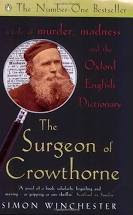The Surgeon of Crowthorne: a tale of murder, madness and the Oxford English Dictionary
Truth really can be stranger than fiction. This book, by Simon Winchester, 1998, is about the relationship between an inmate in an insane asylum and the lexicographer responsible for compiling the first Oxford English Dictionary in the 19th century.
It
was the subtitle of the book that attracted me first: a tale of murder, madness
and the Oxford English Dictionary. Murder
and madness certainly don’t seem to have anything to do with a dictionary and –
when I found out the book was about how this impressive dictionary was first
compiled – I was even more interested in reading it.
The
Oxford English dictionary was the first one in English that aimed to
include every word in the language.
As part of that endeavor, citations of the first use of the word and its
history would be included (where possible). This was such a huge undertaking
that the lexicographer in charge, James Murray, enlisted the help of volunteer readers
throughout the English-speaking world. This help involved having members of the
public send the lexicography team quotations that included the use of the
word in question. These quotations were sent in on slips of paper that were
collected and organized over a period of more than 20 years – about 6 million
slips of paper!
The
most prolific contributor was Dr. William Chester Minor, who turned out to be
an inmate in the Broadmoor Asylum for the Criminally Insane in Crowthorne, England.
Dr. Minor had been a military surgeon in the American Civil War, and moved to
London in 1871. The book details his background, his experiences during the
war, and how he came to murder an innocent stranger after arriving in London. He
was found to be insane, and so sent to Broadmoor.
The
book also has chapters devoted to James Murray, the development of the
dictionary, and the people behind its creation. The book reads like a novel –
with clear characterizations, suspense and emotional power. And I very much enjoyed Simon Winchester’s style of writing. This is his way
of describing how Minor’s contributions multiplied:
- “The first slips of snow-white unlined paper, six inches by four, and covered with Minor’s neat and distinctively American handwriting in greenish black ink, began to drift out from the Broadmoor post-room in the spring of 1885. By the late summer they were arriving at their destination in small brown-paper packets every month, and then larger packets every week. Before long the gentle shower of paper had turned into a raging blizzard, one that was to howl up from Crowthorne unceasingly for almost all of the next twenty years.”
A
very interesting feature of the book is that each chapter begins with a
dictionary entry of a word that is relevant to the topic of the chapter, so it
illustrates the kind of historical information that was given. I not only
enjoyed this book as I would a novel, but I also learned a lot about how the Oxford
English dictionary was compiled.

Comments
Post a Comment